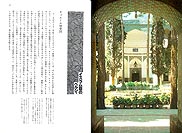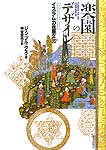We cannot view not only buildings and monuments but also landscapes and gardens apart from the ‘state of mind’ of the people of each era and each society. This is just like costume, which is inevitably restricted by not only individual taste but also the mode of the epoch. The author, bearing their cultural climate and living styles in mind, focuses on garden designs in the Islamic world and searches its principles concretely.
As it is said that the English word ‘Paradise’ originally derives from ‘Pairidaêza’ (enclosed garden) of ancient Persian, the Islamic garden might have been intended to be the materialization of the paradise on earth in the first place.
 Page Sample
Page Sample
In the Islamic world, where idol worship is strictly prohibited, one could not depict the figures of creatures on stone or paper. Instead, highly abstract geometric patterns were developed as aesthetic expression in architectural design, being unparalleled in Europe. The characteristic of this book would be the taking up of the Islamic landscape and gardening on a full scale, which have not been paid enough attention so far. They are wondrous spaces that came into being by being surrounded or partitioned by buildings or walls.
The location of plants and vegetation that have scarcity value in desert areas, the meaning of enclosing spaces, relation to irrigation and other hydraulic techniques, the roles of garden pavilions and porticos; paying attention to these points, the author follows the historical gardens of Persia, Spain, India, Egypt, Sicily, Turkey, and current examples in Islamic countries, analyzing them closely. This is fully rewarding to readers as a history book too, and his non-obtrusive description is much likable partly owing to being a garden designer himself rather than a scholar.
When turning the pages, readers can perhaps feel the astonishment of Christians in the age of crusaders. Europeans at that time would have found the level of Saracenic culture highly sophisticated, perceiving themselves as being in a half-barbarian state. This is a quite valuable book, as one is also able to learn visually that there was and is a self-sufficient civilization outside the Occident.
< from AFTERWORD by the TRANSLATOR >
This book is a complete translation of John Brooks’s “Gardens of Paradise, The History and Design of the Great Islamic Gardens”, 1987, Weidenfeld and Nicolson, London.
The author John Brookes is an active landscape designer, whose activity spans the world. His activity is mainly based in West Sussex, operating his own school of gardening there. He is not only a practical designer but also a writer with an academic mind. He has already written close to ten books, including “Room Outside”, “Garden Design and Layout”, “The Small Garden”, “The Garden Book”, “A Place in the Country”, “The Indoor Garden Book” and so on.
He stayed in Iran for two years from 1978 to 1979 just amidst the backdrop of the Islamic Revolution, teaching landscape design at the Tehran School of Design. This stay seems to have given him the motivation to write this book. He also researched historical gardens other than those in Iran and looked over an extensive number of historical documents. In this book, he not only described the characteristics of gardens in history but also discussed the issues of contemporary Islamic gardens. Moreover, he gave advice to those who were to landscape in Islamic countries, being considered only possible by an active gardener as he was.
For the translator, this book can be said to be a companion volume of the previous book "Architecture de l'Islam" (written by Henri Stierlin, published by Hara Shobo, 1987) translated by myself. As Japanese architectural society have been focusing only on Western architecture since the Meiji era to master it, and still now so after almost having overtook it, it has disregarded the architecture of the Third World, such as Indian or Islamic. In order to improve such a situation even a little, what I translated and managed to publish, notwithstanding being a mere architect, was “Architecture de l’Islam”.
Getting a fortunate reception of the book, I furthermore came to take charge of the translation and publication of a book on Islamic garden design. It is because I empathized with the modest manner of the author John Brooks to learn from Islamic landscape design, differing from erstwhile Europeans as ‘cultural imperialists’ despite being British himself.
|


